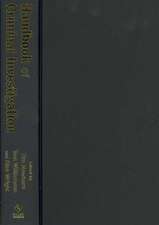Humphry Repton: Landscape Design in an Age of Revolution
Autor Tom Williamsonen Limba Engleză Hardback – 19 dec 2020
Preț: 237.45 lei
Preț vechi: 281.89 lei
-16% Nou
Puncte Express: 356
Preț estimativ în valută:
45.43€ • 47.57$ • 37.60£
45.43€ • 47.57$ • 37.60£
Carte disponibilă
Livrare economică 17-24 martie
Livrare express 01-07 martie pentru 106.56 lei
Preluare comenzi: 021 569.72.76
Specificații
ISBN-13: 9781789142990
ISBN-10: 1789142997
Pagini: 352
Ilustrații: 113 color plates, 19 halftones
Dimensiuni: 184 x 248 x 28 mm
Greutate: 1.22 kg
Ediția:Nouă
Editura: REAKTION BOOKS
Colecția Reaktion Books
ISBN-10: 1789142997
Pagini: 352
Ilustrații: 113 color plates, 19 halftones
Dimensiuni: 184 x 248 x 28 mm
Greutate: 1.22 kg
Ediția:Nouă
Editura: REAKTION BOOKS
Colecția Reaktion Books
Notă biografică
Tom Williamson is professor of landscape history at the University of East Anglia and coauthor of Lancelot Brown and the Capability Men: Landscape Revolution in Eighteenth-Century England, also published by Reaktion Books.
Recenzii
"Humphry Repton, from Jane Austen's world, took a totally different approach. An elegant new life of him by Williamson sheds more light on his working methods than earlier studies. . . . Repton bridged the gap between Capability Brown and the high horticulture of the Victorians and was the first to call himself a landscape gardener. Comfort and practicality were his watchwords and he was as interested in small places as grand ones. There is a lovely chapter on 'Domesticity and Cheerfulness' and many useful design precepts."
"A finely produced and beautifully illustrated look at Repton’s career. Scholarly yet readable, it’s a must-have book for any enthusiast of garden history."
"Often eclipsed in landscape studies by Capability Brown, the earlier designer's self-styled successor is seen here as a practitioner of genius with a system, meticulously followed. The author goes beyond the Red Books to explore influences on Repton, assess collaborative work with his architect son and set the designs within the context of a turbulent age. Copiously illustrated, this is the most important book on Peacock's Mr Milestone for two decades."
"Richly illustrated with examples from Repton’s Red Books and concluding with extensive references and a bibliography, this volume sets Repton and his work firmly in the life and times of the late 1700s–early 1800s in a book that will appeal to those who enjoy reading about garden designers of the past, or garden history."
"It’s sobering to think that Humphry Repton, the English landscape gardener second only in fame to Capability Brown, began his career a year before the Tennis Court Oath was taken in Paris. Cheerful Britain was obviously a world away from bloody France, and Repton took advantage of the calm political situation and rising professional class to undertake much impressive work in the early 1790s. Alas, ‘events, dear boy’ caught up with him as Britain’s war with France began in 1793. Political uncertainty, accompanied by tax increases, caused Repton’s output to slow. This 'Age of Revolution' is the background to Williamson’s impressive book on Repton, out from Reaktion Books and helpfully illustrated with 136 images, 114 of which are in color."
“A fitting tribute to the designer and a celebration of the man who has for so long . . . been lurking in the shrubbery shadows of his predecessor Lancelot Brown. . . . It is, without doubt, the most important study of Repton to appear since Daniels’s magisterial 1999 volume, one that displays a wealth of new research which has been marshalled with thoughtfulness, curiosity, and intellectual dexterity to produce a forensic analysis of a complex man and his landscape aesthetic. Reaktion have produced it beautifully, with copious illustrations that enrich and underscore an effortlessly accessible text. I doubt it will be bettered and it deserves to become required reading for anyone, general reader and garden history aficionado alike, interested in the polite arts of Regency England.”
"A splendid addition to the literature on Repton and to Repton studies. . . . The book is clearly argued and written. It is produced to a very high standard indeed and beautifully illustrated with over 130 color images mainly taken from Repton’s Red Books, but also including maps and plans, and some present-day photographs. . . . Williamson’s latest book is a major contribution to landscape history."
Winner
“This is an important book on Repton, and a tour de force in the social and economic analysis of garden design. Williamson has an unparalleled grasp of what’s at stake in the making of gardens, and a keen sense of Repton’s role in the reimagining of designed landscape. He combines meticulous scholarship with an eye for the telling detail, and his handling of the economics and aesthetics of gardening is unparalleled. Combined with an inspired account of Repton’s friendships and influences, [Williamson’s scholarship] offers us valuable insights into the gardening world that Repton both inhabited and made.”
“Repton’s imagination of the English landscape was incomparable. He was its artist, sculptor, and designer. Williamson admirably charts the evolution of that imagination from the age of Capability Brown through to the aesthetic upheavals of the Regency, always setting it in the social and architectural context of the day. With England’s landscape under unprecedented threat, so clear a championship of Repton's work is exceptionally valuable.”
"This is the most considered account to date of Humphry Repton’s principles, or ‘system,’ of landscape gardening. It draws on the mass of material that Williamson has collected himself in his numerous countywide surveys, and also the publications of County Gardens Trusts in Repton’s bicentenary year, all melded together with Williamson’s many insights in his usual lively style. Repton’s observations and hints on landscape design are of enduring interest, and anyone wishing to understand why this should be so would be advised to immerse themselves in this book."











